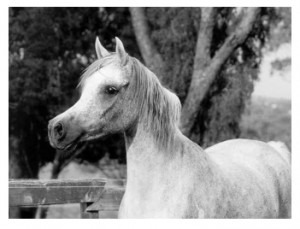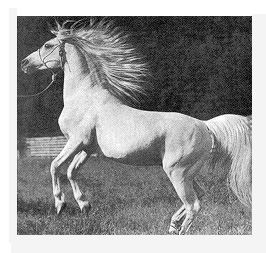Do you remember ‘The Selby Stud’ Ohio?
Adapted from ‘Arabian Exodus’ by Margaret Greely
 Sometimes there are people and horses who remain vivid and real in your memory forever. The Selby Stud, for me, represented a focused commitment to a specific type of Arabian horse, never wavering and always staying true to its owners vision.
Sometimes there are people and horses who remain vivid and real in your memory forever. The Selby Stud, for me, represented a focused commitment to a specific type of Arabian horse, never wavering and always staying true to its owners vision.
To an ideal Pearsons Valeeah
A well-known businessman and a lover of horses all his life, Mr Roger A. Selby was the founder of one of the premium Arabian horse Studs in the 1900’s. An experienced man with horses he decided in his later years to breed Arabian horses. That was, if he was able to find the classic type he most admired.
His first importation was in 1928 when he purchased eight horses from the Crabbet Stud. Among the mares were the greys, Rifala (Skowronek – Rissla) and Kareyma (Naseem – Julnar). Having a mare like Rifala might have been sufficient enough, considering she is the dam of Raffles, and several other notable progeny, but Mr. Selby continued to add to his valuable stock. In 1930 mares like Rose of France (Raswan – Jalila) and Namilla (Nureddin II – Nejmia) were added to the already exceptional brood mare band.
It was in 1932, that Mr. Selby made the greatest contribution to his stud and for that matter to the USA, by purchasing Raffles. This fairy-tale Arabian was an inbred son of Skowronek and stood only 13.3 hands high. A fated purchase which changed the shape of the Arabian horses’ future and even today you can still appreciate the Raffles influence. Raffles became as famous for siring classic Arabian horses in the USA as *Skowronek (Poland) did in England.
Mr. Selby also imported the then twenty three year old Nureddin II a successful sire for Crabbet and also the miraculous white stallion Mirage.
There’s a thoughtful and thought provoking foreword, written by Lady Wentworth for Mr. Selby’s Stud Book which is well worth sharing. I wonder what Lady Wentworth would think when you consider the Arabian horse scene today?
“Mr Roger Selby’s Stud is of the greatest importance, perhaps greater than he himself realizes… It is to America that I look for the energy and foresight to save the Arabian breed and preserve it. Mr Roger Selby is just the man to see further than most people as to the ultimate value of stock.
Blue blood and beauty are perhaps at a discount in the mechanical world of today, but the world of tomorrow will be a dull place if there is no beauty and no aristocracy of equine stock with which to delight the eye and rejoice the heart- man’s heart, for with beauty, symmetry and balance of form are allied comfort, ease and speed… Mr Selby started with the best blood of Arabia. Nothing better can be found anywhere.
He has chosen from the old Crabbet blood and from old stock of the tribes which goes back thousands of years and which has remained unchanged and unspoilt, like the gazelles of the desert, and he will see that no inferior blood spoils its beauty… He is doing great work, but the greatest work of all concerns the preservation of pure blood which he has secured for his stud and which is its main object.”
Time, age and or health can catch up with us all and sadly in 1949 it became necessary that the Selby Stud be drastically reduced. As Margaret Greely states, Arabian breeders in America will remember with gratitude their debt to Mr Selby in the records of the Champions today.



3 Responses
Jane Anderson
“His first importation was of pure Abbas Pasha-Blunt stock in 1928 when he purchased eight horses from the Crabbet Stud. Among the mares were the greys, Rifala (Skowronek – Rissla) and Kareyma (Naseem – Julnar).”
Skowronek pure Abbas Pasha-Blunt stock? Wasn’t Skowronek imported from Poland? He was bred by Count Potocki of Antoniny.
Carmel
Thanks Jane, of course I knew Skowronek was imported from Poland and bred by Count Potocki of Antoniny. Somehow in writing, the article ended up reading incorrectly. Apologies to all who have read this. Jane, I appreciate it when errors are brought to my attention. Many thanks again, Carmel
Theodora Schmoll
I have an original Selby stud book for sale. I do not know its value. open to offers. have documentation. guitartedi@msn.com